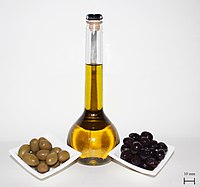
Photo from wikipedia
This study aims to evaluate the impact of incorporating pear, date, and apple by-products on pasta properties. Pasta properties including cooking quality, texture, color, rheology, thermal gelling, and microstructural characteristics… Click to show full abstract
This study aims to evaluate the impact of incorporating pear, date, and apple by-products on pasta properties. Pasta properties including cooking quality, texture, color, rheology, thermal gelling, and microstructural characteristics were evaluated. Common wheat flour was substituted by 0, 2.5, 5, 7, and 10 g/100 g of by-products. To choose the best-suited substitute of flour for the preparation of pasta, the sensorial properties of pasta were investigated. Interrelationships between all the physicochemical parameters were investigated using multiple factor analysis. We also studied the impact of storage (7, 15, and 30 days) on the physicochemical proprieties of pasta. The results revealed that the chemical composition of pasta elaborated with by-products was characterized by higher energy (~386 Kcal) and fiber content (~13%) than the control pasta. Generally, materials added to the durum wheat pasta reduce optimum cooking time, adhesiveness, and extensibility, and enhance the swelling index, cooking loss, cooking water absorption, water activity, firmness, and tenacity of pasta. Cooked pasta samples were significantly (p < 0.05) darker (L*) and greener (-a*) than the control pasta. Increasing the rate of by-products from 2.5% to 10% principally altered the texture and structure of pasta. Scanning electron microscopy analysis showed that the inclusion of by-products into pasta leads to a disruption of the protein matrix. A practical formulation (2.5% of by-products) can be selected, since a significant difference was detected between overall acceptability scores. Grouping the variables in the principal component analysis plot showed that pasta samples can be divided into three groups. Each group was correlated by a specific variable. A significant modification of the physical parameters of pasta was observed after 30 days of storage.
Journal Title: Foods
Year Published: 2022
Link to full text (if available)
Share on Social Media: Sign Up to like & get
recommendations!